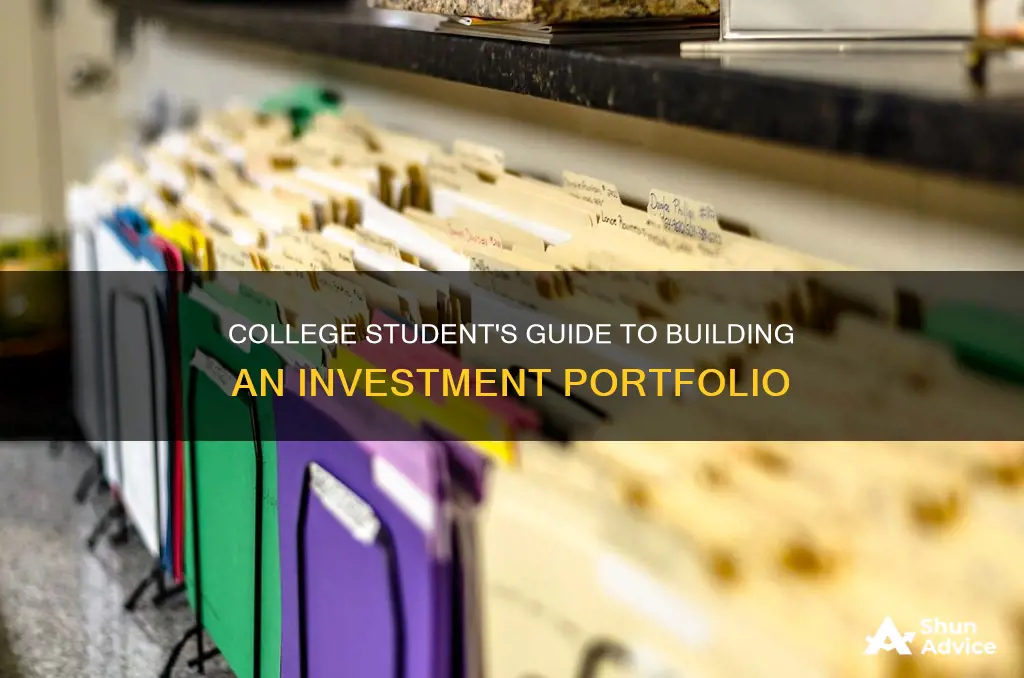
College is a great time for students to start investing. While many students are concerned about the lack of funds, investing does not require a lot of money upfront. In fact, you can start investing with as little as $5 or $20 a month. The key is to start early and be consistent. This will allow you to build a financial foundation and gain valuable experience with real-world money lessons.
There are several investment options available to college students, including stocks, bonds, mutual funds, exchange-traded funds (ETFs), and high-yield savings accounts. It's important to do your research and understand the risks and rewards of each investment type before deciding which one is right for you.
To get started, you can follow these steps:
1. Identify the amount of money you want to invest.
2. Choose your preferred investment type based on your risk appetite.
3. Look for low-cost but reliable trading platforms and brokers.
4. Start by investing a small amount each month to test the waters.
5. Diversify your portfolio over time by investing in different stocks or across various investment types.
6. Consider opening an individual retirement account (IRA) to build your financial future.
| Characteristics | Values |
|---|---|
| Amount to invest | $5-30 a month |
| Investment types | Stocks, bonds, mutual funds, ETFs, high-yield savings accounts, CDs, robo-advisors, micro-investing apps, IRAs, index funds, cryptocurrencies, NFTs |
| Risk appetite | Low-risk investments are safer but have minimal returns; high-risk investments can lead to big gains or losses |
| Diversification | Important to have a variety of investments in different sectors and with different risk levels |
| Research | Do your own research, but also seek advice from professionals |
What You'll Learn

The importance of starting early
Starting early is crucial when it comes to investing as a college student. Here are several reasons why:
- Time is on Your Side: As a college student, you have the advantage of time. Investing early allows your money to grow over a more extended period, leading to potentially larger payouts in the future. The power of compound interest means that your investments can earn interest on both the initial deposit and the accumulated interest over time, resulting in exponential growth.
- Real-World Experience: Investing while in college provides valuable real-world money lessons and experience. You will learn how to manage your finances, sharpen your investment skills, and make more informed decisions by the time you graduate.
- Lower Risk: Investing small amounts early on means that losing money is less risky. You can afford to take calculated risks and learn from your mistakes without the fear of significant financial loss. This trial-and-error period will help you become a more confident and knowledgeable investor.
- Building a Solid Foundation: Starting early enables you to build a solid financial foundation for your future. Even with limited funds, you can begin investing a small portion of your savings and gradually grow your investment portfolio. By the time you graduate, you will have already established a financial cushion and can continue to build on it.
- Retirement Planning: Investing early allows you to start planning for retirement sooner. Exploring options like Individual Retirement Accounts (IRAs) or Roth IRAs can help you maximize tax advantages and build a comfortable retirement fund over time.
- Learning Opportunity: Investing as a college student is an opportunity to educate yourself about the financial markets, different investment types, and risk management. This knowledge will empower you to make more informed decisions and better understand the complexities of investing.
- Motivation to Follow the Market: When you have skin in the game, you are more likely to pay attention to market trends and developments. Starting early will motivate you to conduct research, analyze your holdings, and stay informed about economic and financial news.
In summary, starting early as a college student investor has numerous benefits, including the potential for higher returns, gaining valuable experience, and building a robust financial future. It is a great way to set yourself up for long-term financial success and stability.
Brexit-Proof Your Investment Portfolio: Strategies for Volatile Markets
You may want to see also

Investment options: stocks, bonds, mutual funds, ETFs, etc
As a college student, you can choose from various investment options, including stocks, bonds, mutual funds, and ETFs. Here's a detailed overview of each of these options:
Stocks
Stocks, also known as equities, allow you to purchase a small percentage of ownership in a company. When you buy a stock, you are essentially buying a share of that company. If the company performs well and makes profits, your stock will increase in value. On the other hand, if the company does poorly, the stock price can decrease, resulting in a loss. It's important to adopt a long-term mindset when investing in stocks, as they can be risky due to their volatile nature.
Bonds
Bonds are a type of fixed-income investment, often considered a more predictable and safer option than stocks. When you purchase a bond, you are essentially lending money to a company or a governmental body. In return, the issuer promises to pay you interest at a fixed or variable rate over a set period. Once the bond reaches its maturity date, the issuer repays the original amount, along with the accumulated interest. Bonds are a key component of a balanced portfolio as they can provide stability when stock markets are volatile.
Mutual Funds
Mutual funds are investment vehicles that pool money from multiple investors. This pooled money is then invested in various securities such as stocks, bonds, REITs, and other assets by a professional fund manager. The main advantage of mutual funds is diversification, as they allow you to invest in a wide range of assets without having to purchase individual stocks or bonds. Mutual funds are suitable for those who want a more hands-off approach to investing, as the fund manager actively manages the portfolio to maximize returns.
Exchange-Traded Funds (ETFs)
ETFs are similar to mutual funds in that they also provide diversification by investing in a basket of assets. However, ETFs are traded on stock exchanges like individual stocks, making them more liquid and flexible than mutual funds. ETFs can be bought and sold throughout the trading day, and they often have lower fees than mutual funds. Like mutual funds, ETFs can be an excellent choice for college students who want exposure to different assets without the hassle of picking individual stocks.
Other Options
In addition to the above, college students can also consider investing in high-yield savings accounts, certificates of deposit (CDs), money market funds, and even cryptocurrencies. Each of these options has its own advantages and risk profile, so it's essential to understand them before investing. Additionally, robo-advisors and micro-investing apps are worth considering for those who want a more automated and hands-off approach to investing.
Strategies for Maintaining a Healthy Investment Portfolio
You may want to see also

Understanding risk tolerance
- Risk tolerance refers to the amount of risk an investor is comfortable taking when making investment decisions. It is essential to assess your risk tolerance before investing to ensure that you are making informed and suitable choices.
- As a college student, you may have a higher risk tolerance since you are likely to have a longer investment horizon. This means that you can afford to take on more risk as you have time to ride out market fluctuations and aim for higher returns in the long run.
- However, it is important to note that a higher risk tolerance does not mean that you should invest recklessly. Understanding the risks associated with different investment options is vital. Risky investments can lead to substantial gains but can also result in significant losses.
- To assess your risk tolerance, consider your financial goals, investment horizon, and emotional comfort with market volatility. For example, if you are saving for a short-term goal, such as buying a car in a few years, you may have a lower risk tolerance and opt for more conservative investments.
- On the other hand, if you are investing for retirement over the next few decades, you may be more comfortable taking on higher risk for potentially higher returns. It is crucial to be honest with yourself about your ability to handle market volatility and the potential for losses.
- Diversification is a key strategy to manage risk. By diversifying your investment portfolio across various asset classes, sectors, and industries, you can reduce the impact of market fluctuations on your overall portfolio. This helps to balance risk and return.
- Additionally, it is important to regularly review and rebalance your investment portfolio. As a college student, your financial situation and risk tolerance may change over time. Therefore, periodically evaluating your investments and making adjustments can help ensure that your portfolio aligns with your updated risk tolerance and financial goals.
In conclusion, understanding your risk tolerance is a critical aspect of investing as a college student. By assessing your financial goals, investment horizon, and emotional comfort with risk, you can make more informed investment decisions. Diversification and regular portfolio reviews are also essential tools to manage your risk effectively.
Understanding Investment Analysis and Portfolio Management
You may want to see also

Robo-advisors and micro-investing apps
Robo-advisors are online investment platforms that use software algorithms to create and manage investment portfolios for you. They take the information you provide about your goals, risk tolerance, and investment timeline and use it to build a portfolio that fits your needs. Robo-advisors are ideal for those who want a more hands-off approach to investing and don't want to spend a lot of money on fees. They are also a good option for those who don't have the time or expertise to pick individual stocks or funds.
Some popular robo-advisors for college students include:
- Wealthfront: This robo-advisor offers a range of investment and money management products, including automated investment portfolios, individual stock investing, high-yield cash accounts, and lending capabilities. It has a low account minimum of $500 and charges a competitive annual fee of 0.25% of your balance.
- Betterment: Betterment is a robo-advisor that offers multiple portfolio choices, including socially responsible and crypto investment options. It has a low account minimum of $10 and charges an annual fee of 0.25% for accounts with at least $20,000.
- SoFi Automated Investing: SoFi offers fee-free investment management and access to financial advisors. It has a low account minimum of just $1 and is a good option for those looking for a simple, low-cost investment platform.
- Vanguard Digital Advisor: Vanguard is a well-known name in the investment world, and its robo-advisor service offers basic retirement planning and portfolio management tools. It has a low annual fee of 0.20% and a minimum balance requirement of $100.
In addition to robo-advisors, there are also micro-investing apps that allow you to invest small amounts of money at a time. These apps are designed to make investing more accessible and can be a good option for college students who want to start investing but don't have a lot of money to start. Some popular micro-investing apps include:
- Stash: This app allows you to buy individual stocks or ETFs, and it only takes $5 to get started. The entry-level account costs $3 per month.
- Acorns: Acorns is a micro-saving app that rounds up your purchases to the nearest dollar and invests the difference. It offers three different account tiers, with fees ranging from $3 to $9 per month.
Public Saving and Investment: Two Sides of the Same Coin?
You may want to see also

The power of compound interest
College is a great time for students to start investing, as it gives them real-world money lessons and can set them up for larger payouts in the future. Even with minimal funds, students can begin to build a portfolio and learn about investing and dealing with losses without risking large sums.
One of the most important concepts for college students to understand is the power of compound interest. Compound interest is a way to earn interest on both the money you originally put into an account and the interest you've already earned. So, as time goes on, you not only earn interest on your initial investment but also on the interest you've accumulated. This compounding effect makes your money grow faster and faster over time.
For example, let's say you invest $100 in a savings account with a 5% interest rate. At the end of the first year, you will have earned $5 in interest, giving you a total of $105 in the account. In the second year, you will earn 5% interest on the new balance of $105, resulting in $5.25 in interest. At the end of the second year, your account will have a balance of $110.25, and you will have earned $10.25 without any additional effort. As you continue to reinvest the interest, your balance will grow faster and faster each year.
Compound interest is a powerful tool for growing your wealth over time, and the earlier you start investing, the more you can benefit from the compounding effect. Even small amounts invested during college can accumulate substantially when compounded over time. By taking advantage of compounding, you can amplify the growth of your investment portfolio and set yourself up for long-term financial success.
There are various investment options available to college students, including stocks, bonds, mutual funds, exchange-traded funds (ETFs), and high-yield savings accounts. Each of these options has different levels of risk and potential returns, so it's important to understand them before investing. Additionally, college students can take advantage of tax-advantaged retirement accounts, such as Roth IRAs, to start building their retirement savings early.
In conclusion, college students have the advantage of time when it comes to investing, and understanding the power of compound interest can help them make the most of this opportunity. By investing early and consistently, they can harness the power of compounding to build a solid foundation for their financial future.
Investment Bankers: Crafting Portfolios, Analyzing Fundamentals
You may want to see also
Frequently asked questions
College students can explore a variety of investment options, including stocks, bonds, mutual funds, exchange-traded funds (ETFs), and certificates of deposit (CDs). Stocks allow you to buy a small percentage of ownership in a company, while bonds are loans to companies or organizations that provide a fixed interest rate. Mutual funds pool your money with other investors to invest in a diverse range of stocks and bonds, and ETFs are similar but traded on a stock exchange. CDs are a safe option where you agree to leave your money in the bank for a fixed period in exchange for a higher interest rate.
College students can start investing by opening an individual retirement account (IRA), an online brokerage account, or signing up for a robo-advisor. IRAs offer tax benefits for long-term savings, while brokerage accounts allow you to buy and sell stocks, mutual funds, and bonds. Robo-advisors are digital platforms that provide optimized portfolios based on your risk tolerance and investment goals with low fees and no human interaction.
Before investing, college students should assess their risk tolerance, investment goals, budget, and financial conditions. Understanding your risk tolerance will help you decide between aggressive investments like stocks and ETFs or more cautious options like bonds and mutual funds. Additionally, consider your budget and how much money you can allocate towards investing. It's important to prioritize emergency funds and ensure you have enough to cover essential expenses and loans.







